中大南方英语专业本科论文格式-修订版
英语专业论文范文格式

英语专业论文范文格式----WORD文档,下载后可编辑修改----下面是小编收集整理的范本,欢迎您借鉴参考阅读和下载,侵删。
您的努力学习是为了更美好的未来!英语专业毕业论文格式英语论文用激光打印机打印,打印稿为黑白稿,彩色打印件会影响出版效果。
版心:A4纸,上、下页边距3.5cm,左、右页边距均为3.25mm。
论文内容宽不得超过14.5cm,长不得超过22.5cm。
字体和字号:正文,标题,作者联络信息和图表中的文字均为TimesNewRoman12号字。
可以跟据需要使用同类字体中的粗体,斜体。
行距:单倍行距。
页码:论文正文和文后所附图例都需添加页码。
页码为阿拉伯数字,位于页面下方居中。
文体:文章应语法正确,技术用词准确。
标题应该以最简洁的语言概括文章内容。
如果标题较长,请采用Title:Subtitle的形式。
数学公式:文中的数学公式不得手写,必须打印。
公式如果在文中多次被引用,应该编号。
公式之间,公式和正文之间都应该空一行。
单位:文中所用的度量衡单位应为国际单位。
可在括号内,单位对应表中列出其他单位。
有关国际单位的使用 (StandardPracticeforUseofTheInternationalSystemofUnits)可以通过电话1-800-548-2723向ASCE索取。
其他相关使用参考文献,如ANMCMetricEditorialGuide,5thed,1992可向美国国家公制协会索取(AmericanNationalMetricCouncil,1735N.LynnStreet,Suite950,Arlington,VA22209-2022)图表:标题说明和图例:插入的图表应该以出现顺序编号(Figure1,Figure2,Table1,Table2)。
图的说明和标题,包括图的序号应该位于图的下方。
表的说明和标题,包括表的序号应该位于表格上方。
位置:图可以插入到正文中,或者集中放在文章最后。
英语专业本科毕业论文格式
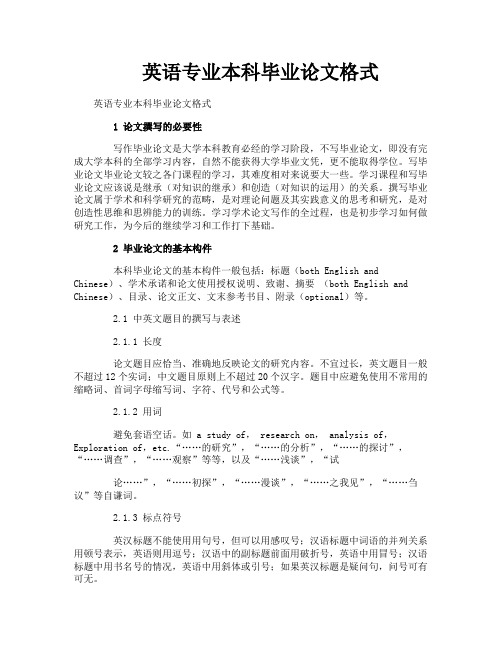
英语专业本科毕业论文格式英语专业本科毕业论文格式1 论文撰写的必要性写作毕业论文是大学本科教育必经的学习阶段,不写毕业论文,即没有完成大学本科的全部学习内容,自然不能获得大学毕业文凭,更不能取得学位。
写毕业论文毕业论文较之各门课程的学习,其难度相对来说要大一些。
学习课程和写毕业论文应该说是继承(对知识的继承)和创造(对知识的运用)的关系。
撰写毕业论文属于学术和科学研究的范畴,是对理论问题及其实践意义的思考和研究,是对创造性思维和思辨能力的训练。
学习学术论文写作的全过程,也是初步学习如何做研究工作,为今后的继续学习和工作打下基础。
2 毕业论文的基本构件本科毕业论文的基本构件一般包括:标题(both English and Chinese)、学术承诺和论文使用授权说明、致谢、摘要(both English and Chinese)、目录、论文正文、文末参考书目、附录(optional)等。
2.1 中英文题目的撰写与表述2.1.1 长度论文题目应恰当、准确地反映论文的研究内容。
不宜过长,英文题目一般不超过12个实词;中文题目原则上不超过20个汉字。
题目中应避免使用不常用的缩略词、首词字母缩写词、字符、代号和公式等。
2.1.2 用词避免套语空话。
如 a study of, research on, analysis of,Exploration of,etc.“……的研究”,“……的分析”,“……的探讨”,“……调查”,“……观察”等等,以及“……浅谈”,“试论……”,“……初探”,“……漫谈”,“……之我见”,“……刍议”等自谦词。
2.1.3 标点符号英汉标题不能使用用句号,但可以用感叹号;汉语标题中词语的并列关系用顿号表示,英语则用逗号;汉语中的副标题前面用破折号,英语中用冒号;汉语标题中用书名号的情况,英语中用斜体或引号;如果英汉标题是疑问句,问号可有可无。
2.1.4 副标题论文题目需要概括出全文主旨,但是一些专业术语、固定短语比较长,放在题目中使得题目字数超过了20个字,去掉又让论文题目不完整,这个时候就可以使用副标题;主标题概括论文的研究内容,副标题主要是限定研究范围或對主标题进行补充说明;汉语副标题前用破折号;英文副标题前用冒号。
英语专业本科论文格式
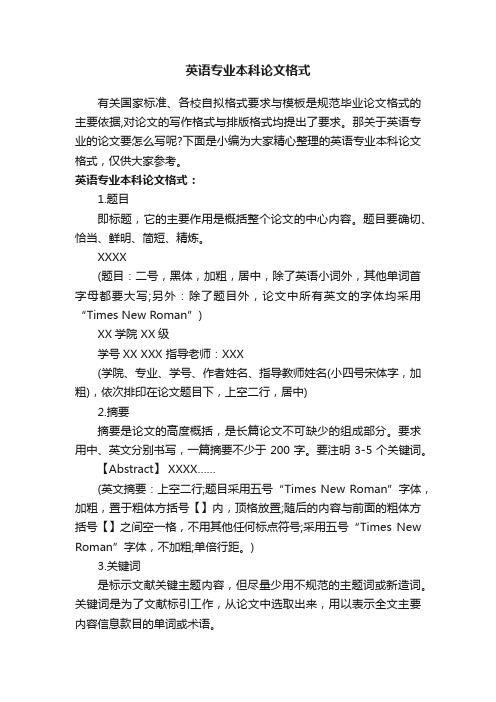
英语专业本科论文格式有关国家标准、各校自拟格式要求与模板是规范毕业论文格式的主要依据,对论文的写作格式与排版格式均提出了要求。
那关于英语专业的论文要怎么写呢?下面是小编为大家精心整理的英语专业本科论文格式,仅供大家参考。
英语专业本科论文格式:1.题目即标题,它的主要作用是概括整个论文的中心内容。
题目要确切、恰当、鲜明、简短、精炼。
XXXX(题目:二号,黑体,加粗,居中,除了英语小词外,其他单词首字母都要大写;另外:除了题目外,论文中所有英文的字体均采用“Times New Roman”)XX学院 XX级学号XX XXX 指导老师:XXX(学院、专业、学号、作者姓名、指导教师姓名(小四号宋体字,加粗),依次排印在论文题目下,上空二行,居中)2.摘要摘要是论文的高度概括,是长篇论文不可缺少的组成部分。
要求用中、英文分别书写,一篇摘要不少于200字。
要注明3-5个关键词。
【Abstract】XXXX……(英文摘要:上空二行;题目采用五号“Times New Roman”字体,加粗,置于粗体方括号【】内,顶格放置;随后的内容与前面的粗体方括号【】之间空一格,不用其他任何标点符号;采用五号“Times New Roman”字体,不加粗;单倍行距。
)3.关键词是标示文献关键主题内容,但尽量少用不规范的主题词或新造词。
关键词是为了文献标引工作,从论文中选取出来,用以表示全文主要内容信息款目的单词或术语。
【Key Words】 XX; XX;XX;XX(英文关键词:题目采用五号“Times New Roman”字体,加粗,两个单词的首字母要大写,置于粗体方括号【】内,顶格放置;随后的内容与前面的粗体方括号【】之间空一格,不用任何其他标点符号,采用五号“Times New Roman”字体,不加粗,除了专有名词外,其他单词的首字母不大写,各单词之间用分号“;”隔开,分号之后空一格;最后一个关键词之后不用任何标点符号;单倍行距。
英文系本科毕业论文格式

英文系本科毕业论文格式英文系本科毕业论文格式新版一、格式论文依次包括封面、目录、英文摘要(Abstract)与关键词(Key words)、中文摘要与关键词、引言(Introduction)、正文、结语(Conclusion)和文献目录(Works Cited)等部分。
二、封面具体样式参照论文样本页A,封面格式可到外国语学院网站下载。
三、标题居中。
如果有副标题,用冒号把英文主、副标题隔开,例如:The Human Nature Motif in William Golding’s Lord of the FliesInvisible Colour versus Visible Wall: Hanif Kureishi’s “Strangers When We Meet”中文副标题须在主标题后另起一行,前面加破折号, 例如:论威廉•戈尔丁《蝇王》中的人性母题看不见的颜色与看得见的墙——评哈尼夫•库雷西的“相逢不相识”四、英文摘要与关键词 Abstract左顶格,字体为Times New Roman 小四号,黑正体,与摘要内容部分以冒号隔开。
摘要内容部分长度为150词以内,字体为Times New Roman 小四号正体,从第二行开始到结束均为左顶格。
关键词部分另起一行,以Key words为标题,关键词标题左顶格,字体为Times New Roman 小四号,黑正体,与所列关键词以冒号隔开,关键词以3至5个为宜,字体为Times New Roman 小四号正体,除少数专有名词外一律小写,关键词之间以分号隔开。
五、中文摘要与关键词摘要左顶格,字体为宋体小四号,黑正体,与摘要内容部分以冒号隔开。
摘要内容部分长度为200字以内,字体为宋体小四号正体,从第二行开始到结束均为左顶格。
关键词部分另起一行,以关键词为标题,关键词标题左顶格,字体为宋体小四号,黑正体,与所列关键词以冒号隔开,关键词字体为宋体小四号正体,关键词之间以分号隔开。
外国语学院英语本科专业毕业论文写作规范
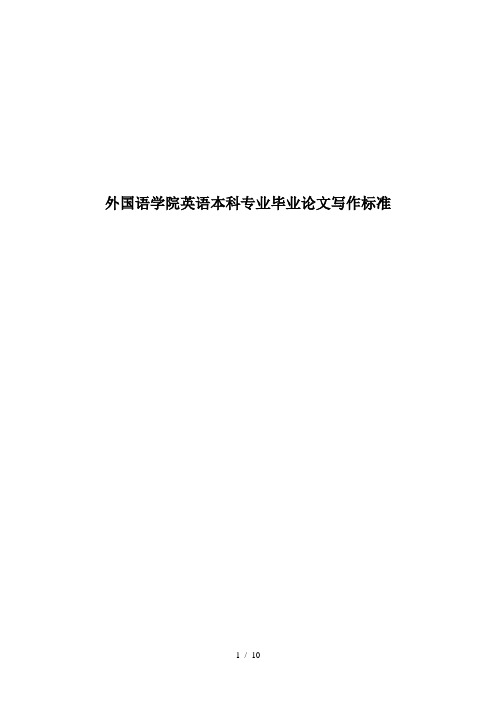
外国语学院英语本科专业毕业论文写作标准论文题目三号字加黑,居中,介词第一个字母不大写Challenge of China State-OwnedCommercial Bank Reforms列出作者、指导教师。
字体四号加黑、居中by Wang LingInstructor:Wang Xiaoping列出所在班级、年级、院系、学校及时间,括号内注明专业方向。
字体四号加黑、居中Class 01,Grade 2004,School of Foreign LanguagesZhongnan University of Economics and LawMay,2021〔题头空3行〕本人声明〔宋体小二号,加粗,居中,空一行〕本毕业论文〔设计〕是在导师的指导下由本人独立撰写完成的,没有剽窃、抄袭、造假等违背学术道德、学术标准和其他侵权行为。
对本论文的研究做出重要奉献的个人和团队a,均已在文中以明确方式标明。
因本毕业论文〔设计〕引起的法律结果完全由本人承当。
〔小4号,宋体,行间距1.5倍〕本毕业论文〔设计〕成果归中南财经政法大学所有。
特此郑重声明。
〔空六行〕毕业论文〔设计〕作者签名:〔空一行〕作者学号:〔空一行〕作者专业:〔空一行〕年月日Contents〔三号字加黑〕以下内容为四号字,不加黑,注意页码是否和文中页码相符。
页码从Introduction 开场到Conclusion为止。
Introduction〔四号字〕 (1)1. Temperament (1)1.1 Being patient (1)1.2 Being active (1)1.3 Being instructive (2)1.4 Being humorous (2)2. Ability (3)2.1 English knowledge (3)2.2 Teaching skills (3)2.3 Management in class (4)3. Method (5)3.1 Classroom activities (5)Use modern facilities to create lively learning atmosphere (5)Change the tedious ways into English debate, speech and game (6)3. 2 Classroom language (6)Encouragement and confirmation language (6)Concise and general knowledge (7)4. Experience (7)Conclusion (8)AbstractAs foreign language teachers, we all know that students come to class with many preconceived ideas about language learning, but very little is known about the nature of these beliefs or how these beliefs might affect language learning strategies. Mainly based on Wen Qiufang, Wang Shouyuan and Horwitz’s study on language learning beliefs, we designed an inventory of 26 items to assess student beliefs in five major aspects: foreign language aptitude, the difficulty of language learning, the nature of language learning, learning and communication strategies, and motivations. This paper will report on and investigate the responses to this inventory of one group of sophomore English majors from Qufu Normal University. Our purpose is to sensitize foreign language teachers to a systematic assessment of the types of beliefs students hold and to the possible influences of these beliefs on foreign language learning.{注}1、Abstract题头采用四号加黑字体,后没有冒号。
英语专业本科毕业论文格式
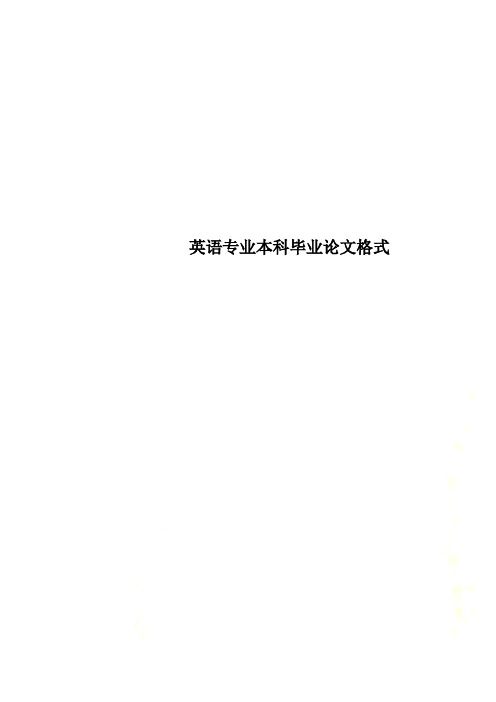
英语专业本科毕业论文格式英语专业本科毕业论文文本格式一、论文文本结构1.封面(由学校统一制作)2.论文英文扉页(见模版及模版说明)3.论文中文扉页(见模版及模版说明)4.致谢(可选项)5.毕业论文英文摘要6.毕业论文中文摘要7.毕业论文英文目录8.毕业论文正文9.注释(可选项)10.参考文献11.附录(可选项)二、论文打印规范1.使用A4纸,单面打印。
2.页边距:上边距3.6厘米,下边距2.5厘米,左边距2.8厘米,右边距2.5厘米。
3.装订线:0厘米。
4.距边界:页眉2.7厘米,页脚1.7厘米。
如下图所示:5.页眉内容:统一为“XX大学XXXX届本科生毕业论文”,使用宋体小五号、居中,(如:XX大学2008届本科生毕业论文)。
6.页码:选用阿拉伯数字,页面底端居中。
第1页为正文第一章的第一页。
目录页和摘要页不标页码和页眉。
三、论文各部分具体格式及要求1.摘要●摘要内容英文采用Times New Roman,12磅,中文采用宋体,小四号;1.5倍行距。
段落首行缩进4个英文字符或2个汉字字符。
●长度:英文约为150词。
中文摘要内容要与英文摘要内容一致。
英文、中文摘要各占一页。
●英文“ABSTRACT”一词字母大写,中文“摘要”之间空两格、加粗、居中,并与内容文字之间空一行(见图1.1 和图1.2)。
●中英文摘要均要求有能反映论文主要内容的关键词2—4个。
“Key words:” 及“关键词:”字样须加粗,顶格。
各关键词之间有分号及一个空格,移行后须与第一个关键词的首字母对齐,英文采用Times New Roman,12磅,中文采用宋体小四号。
图1.1图1.22.目录页●目录页另页编排,置于摘要页的后面。
一级标题加粗,序号采用阿拉伯数字,数字后面加一圆点,如1.、2.、3.等。
二级标题及二级以下标题使用阿拉伯数字编排序号,如3.1、3.1.1 等。
●目录中的各级标题及页码均须与正文中的标题及页码一致。
英语本科论文格式规范
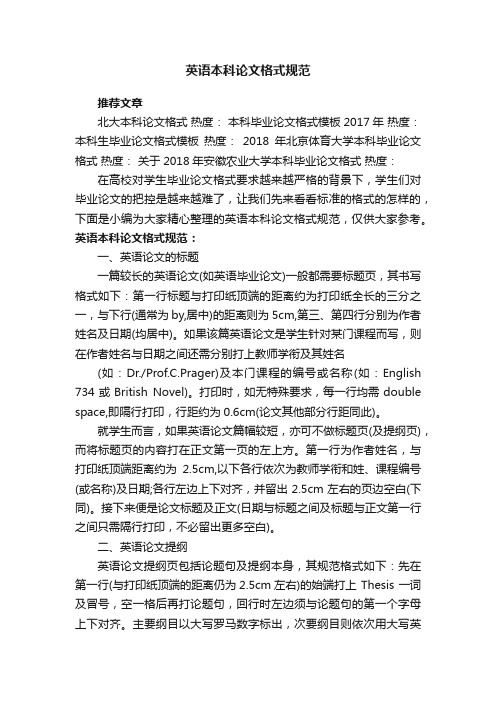
英语本科论文格式规范推荐文章北大本科论文格式热度:本科毕业论文格式模板2017年热度:本科生毕业论文格式模板热度:2018年北京体育大学本科毕业论文格式热度:关于2018年安徽农业大学本科毕业论文格式热度:在高校对学生毕业论文格式要求越来越严格的背景下,学生们对毕业论文的把控是越来越难了,让我们先来看看标准的格式的怎样的,下面是小编为大家精心整理的英语本科论文格式规范,仅供大家参考。
英语本科论文格式规范:一、英语论文的标题一篇较长的英语论文(如英语毕业论文)一般都需要标题页,其书写格式如下:第一行标题与打印纸顶端的距离约为打印纸全长的三分之一,与下行(通常为by,居中)的距离则为5cm,第三、第四行分别为作者姓名及日期(均居中)。
如果该篇英语论文是学生针对某门课程而写,则在作者姓名与日期之间还需分别打上教师学衔及其姓名(如:Dr./Prof.C.Prager)及本门课程的编号或名称(如:English 734或British Novel)。
打印时,如无特殊要求,每一行均需double space,即隔行打印,行距约为0.6cm(论文其他部分行距同此)。
就学生而言,如果英语论文篇幅较短,亦可不做标题页(及提纲页),而将标题页的内容打在正文第一页的左上方。
第一行为作者姓名,与打印纸顶端距离约为2.5cm,以下各行依次为教师学衔和姓、课程编号(或名称)及日期;各行左边上下对齐,并留出2.5cm左右的页边空白(下同)。
接下来便是论文标题及正文(日期与标题之间及标题与正文第一行之间只需隔行打印,不必留出更多空白)。
二、英语论文提纲英语论文提纲页包括论题句及提纲本身,其规范格式如下:先在第一行(与打印纸顶端的距离仍为2.5cm左右)的始端打上 Thesis 一词及冒号,空一格后再打论题句,回行时左边须与论题句的第一个字母上下对齐。
主要纲目以大写罗马数字标出,次要纲目则依次用大写英文字母、阿拉伯数字和小写英文字母标出。
中山大学论文格式规范
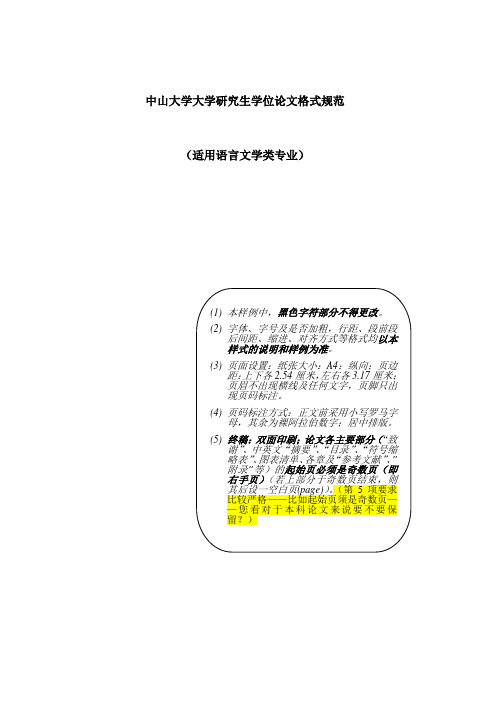
中山大学大学研究生学位论文格式规范(适用语言文学类专业)UDC 编号学号中山大学本科学位论文论文中文题目申请人姓名姓名导师姓名及职称姓名职称申请学位类别文学学科专业名称培养单位外语学院学位授予单位中山大学大学20xx年x月x日UDC __ 编号 学号中山大学本科学位论文Thesis Title论文中文题目申 请 人 姓 名 姓名 导师姓名及职称 姓名 职称 申请学位类别 文 学 学科专业名称论文提交日期 20xx 年4月25日 论文答辩日期 20xx 年6月xx 日 答 辩 委 员 会 姓名 职称(主席)姓名 职称 姓名 职称学位授予单位中山大学Thesis TitleAuthor NameSupervised by Associate Professor NameSubmitted in partial fulfillment of the requirementsfor the degree of Bachelor of ArtsFaculty of English Language and Culture Guangdong University of Foreign StudiesMay 20xxACKNOWLEDGEMENTS I’d like to …摘要本论文……关键词:xxx,xxx,xxx,xxx,xxxABSTRACT This thesis … .………………………Xxx………………Keywords:CONTENTSACKOWLEDGEMENTS (iii)摘要………………………………………………………………………………… v ABSTRACT .………………………………………………………………………………. vii CONTENTS ………………………………………………………………………………… ix xi ...CHAPTER ONE XXX XXX (1)1.1 Xxx xxx .. 1 1.1.1 Xxx xxx ……………………………………….……………………………... 2 ...CHAPTER TWO XXX XXX2.1 Xxx xxx2.2 Xxx xxx 2.2.1 Xxx xxx ………………. ... … … … … …REFERENCES ……………………………………………………………………….……... 71 APPENDICE ……………………………………………………….………………….... 75 Appendix A …….……………………………………………………………………… 75 Appendix B …….…………...……………………..…………………………………… 77 ...在学期间发表论文清单 (83)LIST OF ABBREVIATIONS…...…………LIST OF TABLES……LIST OF FIGURES……CHAPTER ONEXXX XXX XXX1.1 Introductionthesis.1 … Xxxx xxx xxx …… … 1.1.1 xxxxx xxxxx…1Yes, it is the very first sentence.… … … … … … … … … … … … … ………Table 2-1 Xxx xxx xxx… …less efficiently than adults (Nadel and Zola-Morgan 1984).…Nadel and Zola-Morgan (1984) have suggested that infants and young children store memories less efficiently than adults.…According to Nadel and Zola-Morgan (1984:79), “… specific neural structures required for memory storage have not yet matured in children at these ages.”…According to Nadel and Zola-Morgan (1984), “… specific neural structures required for memory storage have not yet matured in children at these ages” (p.79).…It has been claimed that “… specific neural structures required for memory storage have not yet matured in children at these ages” (Nadel and Zola-Morgan 1984:79).…According to Nadel and Zola-Morgan ’s (1984) analysis, … … …In a famous case study of amnesia, Milner, Corkin, and Teuber (1968) describe ... …The results of this study agree with those of Milner et alThe American heritage dictionary (2nd college edn.). (1991) Boston: Houghton Mifflin. … … … … …Brand, M., & Harnish, R. M. (Eds.). (1986) The Representation of Knowledge and Belief .Tucson, AZ: University of Arizona Press. Character education: the role of parents, teachers, and the community. (n.d.). RetrievedOctober 18, 2001, from National Parent Information Network Website: / library/2001/n00584/n00584.html. … … …Clark County schools teaching sign, integrating deaf and hearing students. (1996, January29) Indiana Daily Student , p.4. …Hubel, D. H., & Wiesel, T. N. (1979) Brain mechanisms of vision. Scientific American,241(3), 150-164. ……Jiang, Yan. (1998) Yuyong tuili yu dou de jufa/yuyi tezheng (Pragmatic reasoning andsyntactic/semantic characterization of dou ). Xiandai Waiyu (Modern Foreign Languages) 1, 10-24. …Lǚ, Shuxiang . (1980) Xiandai Hanyu Babai Ci (800 Modern Chinese Words). Beijing:Shangwu Yinshuguan (Commercial Press). … … … … … …Milner, B., Corkin, S., & Teuber, H. L. (1986) Further analysis of the hippocampalsyndrome: 14-year follow-up study of H. M. Neuropsychologia 6, 215-234.Nadel, L., & Zola-Morgan, S. (1984) Infantile amnesia: a neurobiological perspective. In M.Moscovitch (Ed.), Infant Memory…Springer, S. P., & Deutsch, G . (1985)Left Brain, Right Brain (Rev. edn.). New York: W. H.Freeman. …Steinberg, J.A. (1991, March) Putting your business on themap. MacUser, 7, 158-163,166-167. …Swanson, H. L. (1999) What develops in working memory? A life span perspective[Electronic version]. Developmental Psychology, 35, 986-1000.APPENDIXXxxx Xxxx Xxxx Xxxx Xxxx ……APPENDICEXxxx Xxxx Xxxx Xxxx Xxxx ………………Appendix B...………………在校期间发表论文清单……。
英语专业毕业论文格式要求与格式样本(精华版)

英语专业毕业论文格式要求与格式样本(精华版)工作内容阐述: 378091
添加相关内容: 598494英语专业毕业论文格式要求与格式样本(精华版)英 语专业毕业论文格式要求与格式样本(精华版) 823700英语专业毕业论文格式要求与格式样本(精华版)英 语专业毕业论文格式要求与格式样本(精华版)英语专业毕 业论文格式要求与格式样本(精华版) 176340英语专业毕业 论文格式要求与格式样本(精华版)英语专业毕业论文格式 要求与格式样本(精华版)英语专业毕业论文格式要求与格 式样本(精华版)
单击此处添加文本,单击此处添加文本,单击此处添加文本, 单击此处添加文本,单击此处添加文本,单击此处添加文本。
国内研究状况
请输入您想要的文字 请输入您想要的文字
请输入您想要的文字 请输入您想要的文字
这里可以添加主要内容 这里可以添加主要内容 这里可以添加主要内容 这里可以添加主要内容 可以添加主要内容
单击此处添加文本,单击此处添加文本,单击此处添加文本, 单击此处添加文本,单击此处添加文本,单击此处添加文本。
参考文献
这里输入标题文字一
这里可以添加主要内容这里可以添加主要内 容这里可以添加主要内容这里可以添加主要 内容
这里输入标题文字二
这里可以添加主要内容这里可以添加主要内 容这里可以添加主要内容这里可以添加主要 内容
英语专业毕业论文格式要求与格式样本(精华版)工作内容阐述: 661531
添加相关内容: 279912英语专业毕业论文格式要求与格式样本(精华版)英 语专业毕业论文格式要求与格式样本(精华版) 684231英语专业毕业论文格式要求与格式样本(精华版)英 语专业毕业论文格式要求与格式样本(精华版)英语专业毕 业论文格式要求与格式样本(精华版) 380391英语专业毕业 论文格式要求与格式样本(精华版)英语专业毕业论文格式 要求与格式样本(精华版)英语专业毕业论文格式要求与格 式样本(精华版)
中山大学本科生毕业论文格式.doc
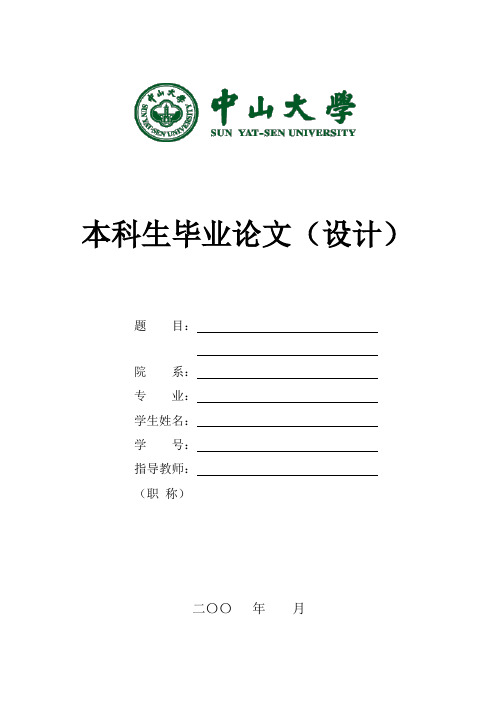
本科生毕业论文(设计)
题目:
院系:
专业:
学生姓名:
学号:
指导教师:
(职称)
二〇〇年月
说明
1、毕业论文(设计)的写作格式要求请参照《中山大学本科生毕业论
文的有关规定》。
2、除完成毕业论文(设计)外,还须填写三份表格:
(1)表一毕业论文(设计)开题报告;
(2)表二毕业论文(设计)过程检查情况记录表;
(3)表三毕业论文(设计)答辩情况(不要求答辩者可不填附表三)。
3、上述表格均可从教务处主页的“表格下载”处下载,如表格篇幅不
够,可另附纸。
每份毕业论文(设计)定稿装订时应随同附上这三份表格。
4、封三是毕业论文(设计)成绩评定的主要依据,请认真填写。
在表中简要陈述。
英语本科毕业论文撰写要求格式1.论文全篇除一级标题外,字体一律小
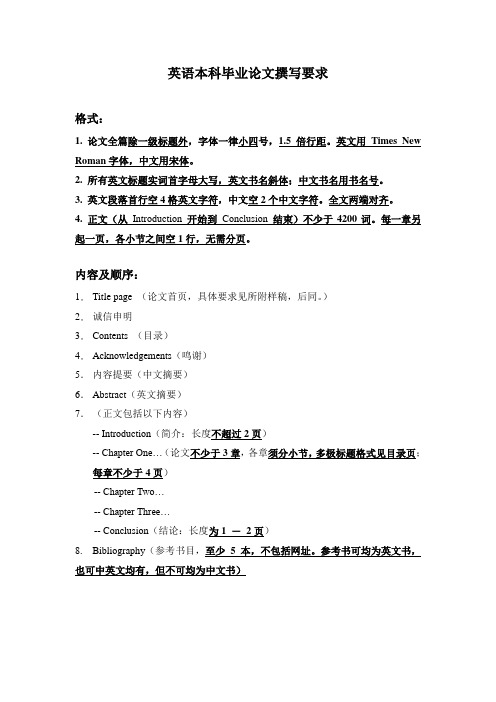
英语本科毕业论文撰写要求格式:1. 论文全篇除一级标题外,字体一律小四号,1.5倍行距。
英文用Times New Roman字体,中文用宋体。
2. 所有英文标题实词首字母大写,英文书名斜体;中文书名用书名号。
3. 英文段落首行空4格英文字符,中文空2个中文字符。
全文两端对齐。
4. 正文(从Introduction开始到Conclusion结束)不少于4200词。
每一章另起一页,各小节之间空1行,无需分页。
内容及顺序:1.Title page (论文首页,具体要求见所附样稿,后同。
)2.诚信申明3.Contents (目录)4.Acknowledgements(鸣谢)5.内容提要(中文摘要)6.Abstract(英文摘要)7.(正文包括以下内容)-- Introduction(简介:长度不超过2页)-- Chapter One…(论文不少于3章,各章须分小节,多极标题格式见目录页;每章不少于4页)-- Chapter Two…-- Chapter Three…-- Conclusion(结论:长度为1 -2页)8. Bibliography(参考书目,至少5本,不包括网址。
参考书可均为英文书,也可中英文均有,但不可均为中文书)样稿(论文首页)Dream Shattered-- A Tentative Analysis of Martin Eden(论文题目,小二号字,该页其余部分四号字。
加粗,居中,实词首字母大写)A Paper Presented toCollege of Continuing EducationShanghai International Studies UniversityIn Partial Fulfillment of the RequirementsFor the Degree of Bachelor of ArtsBy WANG Meiyuan(自己姓名,姓大写,名首字母大写)Under the Supervision ofMr.(或)Ms. Xxx(导师姓名,姓大写,名首字母大写)(空1行)December, 2011(论文定稿完成年月)Contents(所有大标题居中,小三号字,加粗,与下文之间空1行)(论文大小标题以名词或分词短语构成,须提纲挈领。
本科生英语专业毕业论文格式

本科生英语专业毕业论文格式1. 封面:汉语,由教务处统一格式和印制,各学院制作。
题目用汉语。
2. 封二:学生对论文写作内容的声明,文责自负,由教务处统一格式和印制,各学院制作,学生本人填写。
3. 封三:指导教师评定成绩、评语页,统一印制。
4. 封底:()记录、成绩及论文总评成绩。
教务处统一格式,各学院制作。
5. 英文论文封面(English Title Page):由学生按照统一的格式制作。
6. 英文摘要及关键词和中文摘要及关键词(Abstract and Key Words):论文要有200-300字的摘要,能客观反映主要内容信息,具有独立性和包含性。
反映论文主题概念的词或词组,一般每篇3~8个。
单独一页。
7. 提纲和论文陈述(Outline and Thesis Statement):另起一页开始提纲。
8. 正文局部(The Text of the Paper):另起一页开始正文。
学年论文正文字数应在3000字以上6000字以内,毕业论文正文字数应不少于6000字。
文内夹注格式参照教材《英语学术论文写作》和“论文模板”。
1. Introduction2. Body3. Conclusion9. 尾注(Notes):另起一页开始尾注。
10. 引用文献(Works Cited):英献在前,汉献在后,另起一页附引用文献。
引用文献格式参照教材《英语学术论文写作》和“论文模板”。
11. 全篇论文格式参见本文档中的“论文模板”。
12. “论文模板”中未详尽例举的格式,请参阅教材《英语学术论文写作》。
13. 论文要求一律用A4纸张单面打印,统一按word格式A4纸(“页面设置”按word默认值)编排、打印。
14. 需要上交存档的论文一式两份,按封面、封二、、指导检查情况记录表、正文、指导教师评分表、辩论及成绩评定记录表依次装订。
辩论时提交给评议教师提交论文的分数另行决定。
12级中大南方英语专业本科论文格式

英语专业本科论文格式说明目录一、前置部分 (1)(一)封面 (1)(二)英文、中文摘要和关键词 (1)(三)目录 (2)二、主体部分 (4)(一)正文 (4)(二)注释 (6)(三)参考文献(References) (10)三、后置部分 (18)(一)附录 (18)(二)致谢 (18)(三)过程检查表 (18)(四)答辩记录登记表 (18)四、注意事项 (19)(一)论文正文中的引用格式,供参考: (19)(二)页码(放在页面底端中间) (19)(三)图表使用格式 (20)(四)整份论文包含的内容 (21)一、前置部分(一)封面毕业论文的封面及封底由学校统一印发。
(二)英文、中文摘要和关键词英文摘要字数约250-300字左右,中文摘要与英文内容基本对应,原则上字数不超过一页。
摘要内容概括论文主要信息,包括研究主题、研究目的、研究方法、结论或相关启示。
并在摘要下面列出3-5个关键词。
(具体格式如下)ABSTRACT(标题位于页面首行并居中,大写,三号Times New Roman加粗,与下文空开一行)×××××××××××××××××××××××××××××××××××××××××××××××××××××××××××××××××××××××(摘要正文每段首行缩进四个英文字符,用小四号Times New Roman,1.5倍行距)××××××××××××××××××××××××××××××××××××××××××空一行Keywords:×××, ××××, ×××关键词缩进四个英文字符,Keywords一词本身用四号Times New Roman加粗。
中山大学本科生毕业论文格式模板
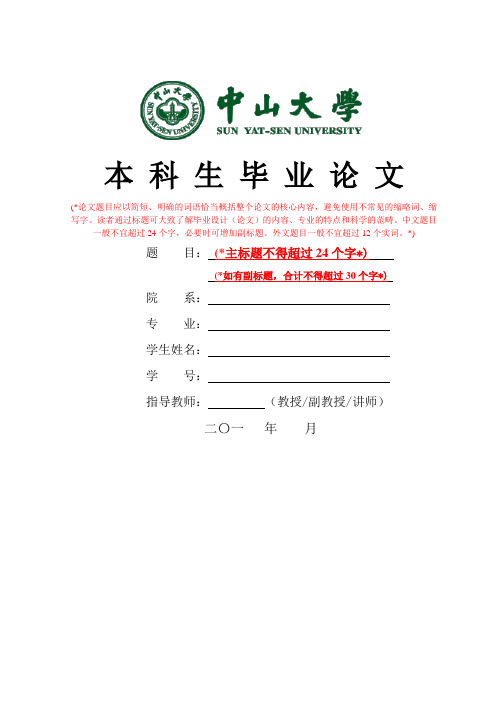
本科生毕业论文(*论文题目应以简短、明确的词语恰当概括整个论文的核心内容,避免使用不常见的缩略词、缩写字。
读者通过标题可大致了解毕业设计(论文)的内容、专业的特点和科学的范畴。
中文题目一般不宜超过24个字,必要时可增加副标题。
外文题目一般不宜超过12个实词。
*)题目:(*主标题不得超过24个字*)(*如有副标题,合计不得超过30个字*)院系:专业:学生姓名:学号:指导教师:(教授/副教授/讲师)二〇一年月本人所呈交的毕业论文,是在导师的指导下,独立进行研究工作所取得的成果,所有数据、图片资料均真实可靠。
除文中已经注明引用的内容外,本论文不包含任何其他人或集体已经发表或撰写过的作品或成果。
对本论文的研究作出重要贡献的个人和集体,均已在文中以明确的方式标明。
本毕业论文的知识产权归属于培养单位。
本人完全意识到本声明的法律结果由本人承担。
本人签名:日期:摘要(* 中文摘要不少于300字。
摘要、关键词和设计说明1.中文摘要和中文关键词摘要内容应概括地反映出本论文的主要内容,主要说明本论文的研究目的、内容、方法、成果和结论。
要突出本论文的创造性成果或新见解,不要与引言相混淆。
语言力求精练、准确,以300—500字为宜。
在摘要的下方另起一行,注明本文的关键词(3—5个)。
关键词是供检索用的主题词条,应采用能覆盖论文主要内容的通用技术词条(参照相应的技术术语标准)。
按词条的外延层次排列(外延大的排在前面)。
摘要与关键词应在同一页。
2.英文摘要和英文关键词英文摘要内容与中文摘要相同,以250—400个实词为宜。
摘要下方另起一行注明英文关键词(Keywords3—5个)。
*)关键词:(*关键词1;关键词2;……关键词一般为论文中出现的重要的、描述主题的词;应包含技术领域和问题领域两大类关键字;尽量不要使用组合词;中英文关键词不少于3个,不多于5个。
*)ABSTRACT(* 英文摘要不少于500单词,严格使用英文标点符号。
英语本科论文格式要求(2篇)
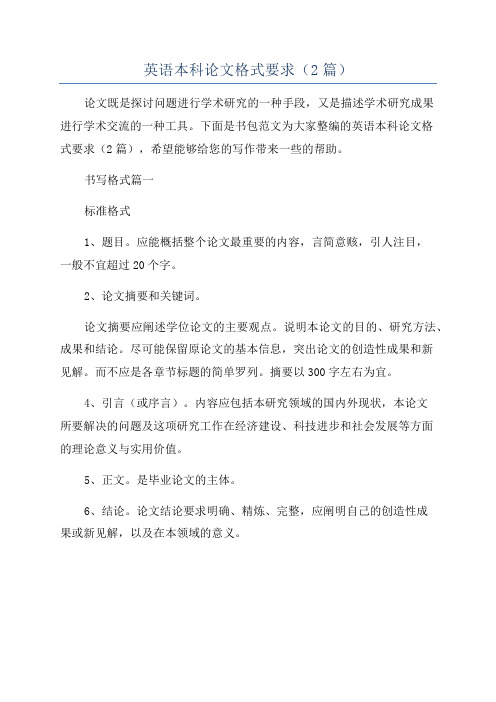
英语本科论文格式要求(2篇)
论文既是探讨问题进行学术研究的一种手段,又是描述学术研究成果
进行学术交流的一种工具。
下面是书包范文为大家整编的英语本科论文格
式要求(2篇),希望能够给您的写作带来一些的帮助。
书写格式篇一
标准格式
1、题目。
应能概括整个论文最重要的内容,言简意赅,引人注目,
一般不宜超过20个字。
2、论文摘要和关键词。
论文摘要应阐述学位论文的主要观点。
说明本论文的目的、研究方法、成果和结论。
尽可能保留原论文的基本信息,突出论文的创造性成果和新
见解。
而不应是各章节标题的简单罗列。
摘要以300字左右为宜。
4、引言(或序言)。
内容应包括本研究领域的国内外现状,本论文
所要解决的问题及这项研究工作在经济建设、科技进步和社会发展等方面
的理论意义与实用价值。
5、正文。
是毕业论文的主体。
6、结论。
论文结论要求明确、精炼、完整,应阐明自己的创造性成
果或新见解,以及在本领域的意义。
英语专业本科毕业论文模板兼撰写规范

英语专业本科毕业论文模板兼撰写规范20xx届本科英语专业本科毕业论文兼撰写规范姓名:吕仁爱系别:外语学院专业:英语学号: 00000000指导教师:赵草稿20xx年5月thesis writing standard for english major undergraduates:with a thesis patternbylü ren’aishangqiu normal universitymay 20xx摘要{摘要是论文的浓缩,应包括结论等内容,是完整的短文,具有独立性,可以单独使用。
即使不看论文全文的内容,看摘要仍然可以理解论文的主要内容。
切忌把导论(introduction)的内容作为摘要内容。
在下段键入中文摘要内容,并用论文的关键词替换“关键词”后的词(删除多余的词)。
如果需要输入顿号(、)、间隔号(·)、书名号(《》)、破折号(——)等标点符号,不会键入请从这里复制。
中文摘要要求在200~300字。
}关键词:词1;词2;词3;词4;词5abstract{英文摘要及关键词内容与中文内容完全一致。
注意看懂附录部分标点符号部分的内容,不要用不规范的形式输入标点符号,更不要输入错误符号。
在下段键入英文摘要内容并用论文的关键词替换“key words”后的词(删除多余的词)。
}key words: word 1; word 2; word 3; word 4; word 5contents摘要 iabstract iicontents iii1 简介 12 电子版与纸质版 13 模板的使用 13.1 键入文本 23.2 应用格式 24 论文结构与写作要求 24.1 封面与题目 34.1.1 封面 34.1.2 题目 34.2 从摘要到目录 34.3 正文 34.3.1 总体要求 34.3.2 标题和层次 34.3.3 例句及其他列表项 44.3.4 脚注 44.3.5 引用标识与参考文献 44.3.6 附录(可选) 64.3.7 页眉 65 其他要求及注意事项 6references 7附录标点符号的计算机输入 7简介{本科毕业论文是本科生毕业前的最后一个重要学习环节,是学习深化的重要过程。
英语专业毕业论文格式基本要求规范(完整版)
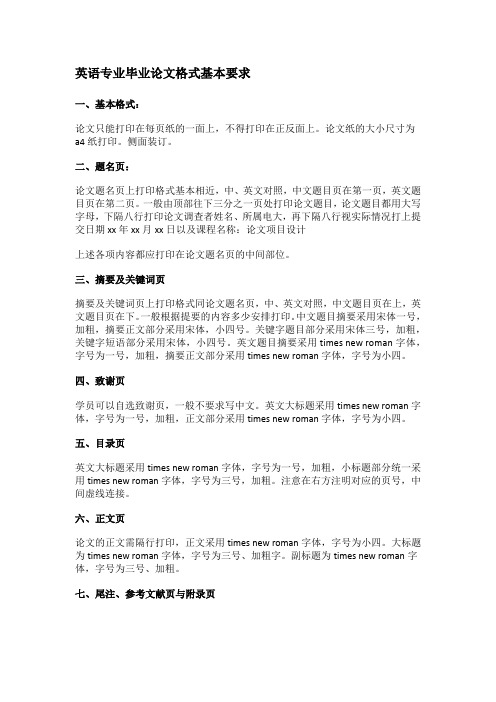
英语专业毕业论文格式基本要求一、基本格式:论文只能打印在每页纸的一面上,不得打印在正反面上。
论文纸的大小尺寸为a4纸打印。
侧面装订。
二、题名页:论文题名页上打印格式基本相近,中、英文对照,中文题目页在第一页,英文题目页在第二页。
一般由顶部往下三分之一页处打印论文题目,论文题目都用大写字母,下隔八行打印论文调查者姓名、所属电大,再下隔八行视实际情况打上提交日期xx年xx月xx日以及课程名称:论文项目设计上述各项内容都应打印在论文题名页的中间部位。
三、摘要及关键词页摘要及关键词页上打印格式同论文题名页,中、英文对照,中文题目页在上,英文题目页在下。
一般根据提要的内容多少安排打印。
中文题目摘要采用宋体一号,加粗,摘要正文部分采用宋体,小四号。
关键字题目部分采用宋体三号,加粗,关键字短语部分采用宋体,小四号。
英文题目摘要采用times new roman字体,字号为一号,加粗,摘要正文部分采用times new roman字体,字号为小四。
四、致谢页学员可以自选致谢页,一般不要求写中文。
英文大标题采用times new roman字体,字号为一号,加粗,正文部分采用times new roman字体,字号为小四。
五、目录页英文大标题采用times new roman字体,字号为一号,加粗,小标题部分统一采用times new roman字体,字号为三号,加粗。
注意在右方注明对应的页号,中间虚线连接。
六、正文页论文的正文需隔行打印,正文采用times new roman字体,字号为小四。
大标题为times new roman字体,字号为三号、加粗字。
副标题为times new roman字体,字号为三号、加粗。
七、尾注、参考文献页与附录页尾注、参考文献页与附录页(大标题采用times new roman字体,字号为一号,加粗)正文部分如尾注、参考文献目录与附录可不必隔行打印,字体为times new roman小四。
【VIP专享】英语专业本科毕业论文格式标准范文

without theespecially that of教师素质一直都备受关注,特别是小学教师的素质更是如此,因为小学教ACKNOWLEDGEMENTS (I)A Follow-up Study on Transferred Teachers’ English Pronunciation——A Case in Guangdongvaluable perspectives on teaching and curriculum development.1.4 Structure of the Present StudyStarting from definition, the author first of all found out some experts’ definition of “teachers’ beliefs”, and then summed it up to be a much plain one. Then the author proceeded to make analysis of the questionnaires, aiming at finding out the status quo of teachers’ beliefs in GD Province. After that, the author made further analysis on the classroom observation log, trying to find out whether the teachers’ teaching behavior was consistent with their articulated beliefs. Finally, face-to-face interviews were conducted to find out how teachers’ beliefs guide their behavior, and what teachers usually take into account in their course planning.Chapter Two Literature Review2.1 Definition of Teachers’ BeliefsDefinition of beliefs may vary according to different experts. Sigel (1985) defines beliefs as mental construction of experience, which guides behavior. Nespor (1987) and William & Burden (1997) define it as values and attitudes of the world and is also predictor of behavior. To be brief, beliefs tell behavior.In 1992, Pajares made a definition of “teachers’ beliefs” as teachers’ attitudes about education, about schooling, teaching, learning, and students (Pajares 1992). Nespor (1987), Woods (1996) and William & Burden (1997) found teachers’ beliefs is far more influential than knowledge in determining classroom work. Breen et al (2002) also infers that teachers’ beliefs and experiences strongly influenced classroom work.From all the above definitions, the author summed up “teachers’ beliefs” to be teachers’ attitudes about teaching and learning, which will affect everything they do in the classroom teaching.2.2 Teachers’ Beliefs and Teaching BehaviorThe western countries had gone through 3 decades in the research of the relationship between teachers’ beliefs and teaching behavior. Freeman (2002) subdivides the period into 3 broad time frames: work leading up to 1975, the decade of change (1980-1990), and the decade of consolidation (1990-2000).Since the 80s, an array of empirical studies of teachers’ beliefs and teaching behavior have been carried out. Freeman (2002) probed the impact of teachers’ mental lives, prior knowledge, social and institutional context, etc. on teaching behavior, and found teachers’ beliefs to have a powerful influence on their behavior. Actually, how teachers’ beliefs shape their behavior in classroom teaching has been studied in various ways (Meighan 1990; Woods 1996; Smith 1997; Breen et al 2001; Borg 2003; Burns 2005).Chinese researchers have begun to set about studying teachers’ beliefs and teaching behavior in recent years (Wang 2002; Xia 2002; Sun 2005; Lou & Liao 2005).All these studies collectively show that classroom activities are highly influenced by teachers’ beliefs. However, some researchers found their subjects to behave the other way round.Argyris & Schön (1974, 1987) argue that there is almost always a discrepancy between teachers’ beliefs and the ways teachers act (William & Burden 1997). Sun (2005) addresses that the most prominent problem in English classroom teaching to bethe gap between the newly acquired teaching beliefs and the educational practice. Wang (2002) and Lou & Liao (2005) also found such a discrepancy between their subject teachers’ behavior and beliefs. If there really exists such a discrepancy, the teaching may be inefficient or even confusing, which may bring about a series of problems in teaching and learning.2.3 The Expected Teachers’ Beliefs of the New CurriculumChances are that given better teaching, learners will learn more. The new era of education calls for improved teaching beliefs and behavior as instruments to facilitate and improve student learning. The newly implemented curriculum put forward five teachers’ beliefs as follows:Focusing on common foundation, preparing for further development;Offering various options, catering for personal needs;Optimizing the learning model, enhancing self-directed learning competence;Concerning with students’ emotion, enhancing cultural awareness;Promoting the assessment system, encouraging continuous development.(cited from Senior English Curriculum 2003:2-3)As a matter of fact, such beliefs were raised to meet the new demands of our society, to meet the new learning needs of our students. On condition that teachers’ beliefs and teaching were consistent with the New Curriculum, fruitful teaching outcome would be yielded.However, the questions are: What’s the status quo of teachers’ beliefs? Do they behave in accordance with their articulated beliefs? And what do the teachers usually take into account in teaching? To find out all the corresponding answers, the author carried out a survey of teachers’ beliefs and teaching behavior in GD Province.Chapter Three MethodThe survey consisted of 3 instruments: ① a teacher questionnaire developed by the author (consisted of three sections: Section One--personal data and experience, etc; Section Two--a 25 item teacher belief section based on the 5 guidelines of the New Curriculum in senior high published by the Ministry of Education (Item 1–5 on Belief 1, Item 6-10 on Belief 2, and the rest may be deduced by analogy); Section Three--2 open questions about teachers’ beliefs and teacher concern) (See Appendix 1); ②an observation log (comprising general information and a 10-period classroom observation log (See Appendix 2); ③an interview outline (See Appendix 3).A pilot study was conducted in one TypeB school from Guangzhou in early September 2005. Based on the feedback from the pilot study, the author made revisions in the survey instruments.3.1 The Participants10 schools from 5 of the cities in GD Province participated in this study. The participants were carefully chosen: the capital city of GD--Guangzhou (广州), two peripheral cities--Foshan (佛山) and Nanhai (南海), two relatively remote cities--Puning (普宁) and Shantou (汕头), respectively. 10 researchers divided the 10 schools among them during their teaching practices. However, only 8 schools’ data were intact and possible for analysis. Altogether, there were 27 teachers from these 8 schools.Table 1 summarizes the characteristics of all the subject teachers. 18 worked in Grade One, and 9 worked in Grade Two. There were 17 female and 10 male teachers. The teachers had varying degrees of general teaching experience ranging from 1 to 43 years. The average teaching experience across the sample was 12.7 years. Among them, 26 teachers had received the New Curriculum training.Table 1. The Teachers’ CharacteristicsGender Grade Curriculum Training Male Female One Two Received Not Yet Average Teaching Experience (year)No.101718926112.7For the sake of being as objective as possible, School 7 and School 8 also excluded in the following discussions, because only one subject teacher was available from each of these two schools. Consequently, the following results and discussions were based on 6 schools.3.2 Procedures3.2.1 The Teacher Questionnaire SurveyFirstly, the researchers invited the teachers to fill in the Teacher Questionnaire (TQ) and fixed a time with the teachers for classroom observation. Teachers filled in the general information and indicated the level of endorsement of each of the 25 items using a 5-point Likert-type scale comprising the categories “strongly disagree,” “disagree,” “somewhat disagree, somewhat agree,” “agree,” and “strongly agree,” scored as 1 through 5, respectively; then they responded to the 2 open questions concerning with teachers’ opinions and suggestions of the New Curriculum (see Table 2).Table 2. The 2 Open Questions in the Teacher QuestionnairePlease write down your opinions and suggestions of the New Curriculum1. The mostobvious changes①…②…③…2. The most urgent problems to be solved ①…②… ③…As is shown in Table 2, Question 1 tells whether teachers have noticed the most obvious changes of the curriculum. And Question 2 enables the author to perceive the teachers’ most concern, which would serve as a basis to find out whether teachers adopted particular teaching strategies to enhance their students’ weak point, since they have noticed where the problems lied.3.2.2 Classroom ObservationAs there may exist a discrepancy between teachers’ beliefs and behavior, and apart from this, teachers may overstate or understate the beliefs underlying their actual practice. Therefore, whether teachers teach in accordance with their beliefs can only be revealed from the observation of practical teaching.Hence, the second data collection method was based upon a substantial classroom observation log. The researchers recorded 10 periods of English classes of every subject school. The 10 English classes were not specifically chosen, but observed at random, generating a thorough and objective data. The observation focused onclassroom activities, multimedia applied, textbook dealt, assessment forms, and optional courses, etc.3.2.3 The InterviewIn order to comprehend more about how teachers’ beliefs guide their behavior, and what teachers usually take into account in their teaching, face-to-face interviews were added, and the interview with teachers was semi-structured. Table 3 shows the outline of the interview.Table 3. Outline of the Semi-structure InterviewInterview Subject: Senior High English Teachers in Guangzhou①How do you usually design a lesson? And what about activities?②How do you like the present textbook? And how do you apply it?③Do you think it is necessary for students to enhance their cultural awareness?How do you help your students enlarge their scope of background knowledge?The author arranged interviews with 12 Senior One English teachers from 6 schools (Comprising Type A, Type B and Type C schools) in GZ, 2 teachers from every subject school participated in the interview. The interviews were recorded implicitly by mp3, and were transcribed into written language later.3.2.4 Data AnalysisAll data were analyzed using the Statistical Package for Social Scientists (SPSS),release 10.0 and Microsoft Excel, release 2003.Mean and standard deviation of the TQ were analyzed by using Descriptives; histograms were generated by using Excel to illustrate the results more plainly. And within-group differences of 25 teachers’ beliefs of the 6 subject schools were analyzed by using One-way ANOVA.Chapter Four Results and DiscussionAfter all the data were collected, the author began to arrange the data and analyze them. Firstly, the author sorted out all the received questionnaires. And found out the valid percent of the TQ was 100%. Table 4 indicates the general information of the questionnaires obtained from the 6 schools.Table 4. Information of the Received TQQuestionnaire Received Valid Invalid Valid Percent Number25250100%4.1 Status Quo of the Teachers’ Beliefs4.1.1 Mean and Std. Deviation of the TQStarting from data analysis, the author carried out Descriptive Statistics analysis to analyze the TQ, showing that all the means of the 5 beliefs are within the range of“3.5 to 4.4”, therefore, conclusion can be drawn that all the subject teachers “Agree①” with every belief advocated in the New Curriculum. Then the author put the data from Figure 1 into the Microsoft Excel, generating a histogram as follows:Beliefs N Mean S.D.B 125 4.0560.4917B 225 3.9920.6843B 325 4.3600.5132B 425 4.3440.5050B 525 3.9040.5200As is illustrated above, the histogram indicates that the means of Belief 2 (Offering various options, catering for personal needs) and Belief 5 (Promoting the assessment system, encouraging continuous development) score the lowest among the five beliefs. The causes of this result maybe: optional class and formative evaluation, etc. are newly advocated, compared with the other beliefs; and it takes time to get thorough endorsement from all the teachers. Whereas, those of Belief 3 (Optimizing learning model, enhancing self-directed learning competence) and Belief 4 (Concerning with students’ emotion, enhancing cultural awareness) score relatively high, because learner-centered and background knowledge have been heard of long before.After that, the author made another Descriptive Statistics analysis to find out themean and standard deviation of the teachers’ beliefs in every subject school. Figure 2 illustrates the results of the Descriptive Statistics analysis. Mean of 4 of the subject schools is also within the range of “3.5 to 4.4”, a same conclusion can be drawn that these schools “Agree” with the New Curriculum; and School 2 and School 3 got a mean higher than “4.4”, what’ more, mean of School 2 is within “4.5 to 5”, which indicates that teachers from school 2 “Strongly agree” with the New Curriculum.Schools N Mean S. D.S 15 3.7280.4502S 24 4.5300.3523S 34 4.4100.3965S 43 4.0933.3717S 53 3.7867.2344S 66 4.2067.4236Total25 4.1312.4607Figure 1 and Figure 2 reveal that teachers from every subject school “ Agree” or “ Strongly agree” with every teacher’ s belief put forward in the New Curriculum. Figure 2 also indicates that teachers’ beliefs differ in different schools. The histogram displays impressive differences among the subject schools plainly, and school 1 & 5 bear a great distance from School 2 &3 in the endorsement of the New Curriculum. To confirm this hypothesis, a One-way ANOVA analysis was conducted.4.1.2 A Comparison of Teachers’ Beliefs in Every Subject SchoolWhen means of the beliefs were compared, the One-way ANOVA results indicated that teachers’ beliefs in different schools differed significantly, sig. = .047, P<0.05 (illustrated in Figure 3). Since 26 out of the 27 teachers have got the New Curriculum training. The possible causes of such difference may be due to teachers’ different interpretation of the New Curriculum, restraint of their students’ level or confinement of the particular teaching context in every subject school.Figure 3. One-way ANOVA of Teachers’ BeliefsSum of Squares df Mean Square F Sig. Between Groups 2.1555.431 2.786.047 Within Groups 2.93819.155Total 5.09324To make a classification of all the subject schools, Homogeneous Subsets analysis was directed. Figure 4 demonstrated that teachers’ beliefs in School 1 and School 5 were significantly different from those in School 3 and School 2, for they are not in the same column. School 4, 6, 3 and 2 are identical in terms of endorsement of the New Curriculum, because they are in the same column.Figure 4. Homogeneous Subsets of Every Subject SchoolN Subset for alpha = .05Schools123School 15 3.7280School 53 3.7867 3.7867School 43 4.0933 4.0933 4.0933DuncanSchool 66 4.2067 4.2067 4.2067School 34 4.4100 4.4100School 24 4.5300Sig..134.054.170Uses Harmonic Mean Sample Size = 3.913.Descriptive Statistics of the TQ revealed that all subject teachers from GD Province “Agree” or “Strongly agree” with the New Curriculum. And One-way ANOVA analysis illustrated that teachers’ beliefs varied from one school to another. School 2 and school 3 scored the highest among the 6 schools, which indicated that they endorsed the New Curriculum the most. However, chances are that some teachers showed great approval to the New Curriculum just because they knew about it from the teacher training. However, how they behave in actual teaching still remains a question. Furthermore, teachers’ articulated beliefs is one thing and how they apply their beliefs into teaching is another thing.4.2 The Relationship between Teachers’ Beliefs and Their Teaching BehaviorTo find out whether teachers teach in light of their beliefs, analysis of the answers to the 2 open questions in the TQ was conducted. With the teachers’ most concern in mind, further analysis on whether teachers adopted particular strategies to tackle the obstacles was directed.4.2.1 Teachers’ Articulated BeliefsThe data revealed almost 72 opinions and suggestions put forward by all the subject teachers. Table 5 listed out five most widely shared categories of teacher concern for each question.Table 5. Teacher Concern on the Current Curriculum and TeachingItem 1. The most obvious changes of the New Curriculum① more demanding for teachers and students;② renewal and increase of the capacity of the textbook;③ more interaction between teachers and students;④focus more on cultivating students’ integrative ability in learning, knowledge applying,participation, cooperation and communication;⑤ closer to authentic daily life.Item 2. The most urgent problems to be solved① the renewal of teachers’ teaching beliefs and students’ expectations of teaching;② the conflict between the New Curriculum and the College Entrance Examination(the conflict between integrative skills development and exam-oriented education);③ the conflict between students’ ability and the highly demanding new teaching materials andactivities (esp. listening);④ the coherence of the junior high textbook and senior high one (esp. vocabulary);⑤large capacity of the content in the textbook versus inadequate course hours (not enoughtime for assimilation and consolidation).To sum up, most teachers have noticed the renewal of the curriculum and have perceived its characteristics and advantages. They also found the current curriculumto be more demanding for their students, owing to the dramatically increased capacityof the textbook and limited course hours. In the meantime, they call for coherence ofthe junior high and senior high curriculum, and new testing formula. These are theshared concern of most teachers, however, the questions are: Since they’ve noticedthe problems, did they adopt particular teaching behavior to make up for this? Or howmany teachers have attempted to? Only substantial observation could tell.4.2.2 Observation Log of Practical Classroom TeachingBearing the teachers’ most concern in mind, the author proceeded to analyze allthe data on the teachers’ behavior in the classroom as recorded in the 6 researchers’ classroom observation logs. The 10-period classroom observation logs recorded morethan 5 teachers from Grade One and Grade Two in every subject school. Hence, thesedata covered a range wide enough to represent the whole subject school.Classification and analysis of the observation log revealed that most schools adopted the textbook New Senior English for China, while schools in Foshan and Nanhai adopted the one Senior High English. Nearly all the schools applied the textbooks flexibly by supplying extra materials, omitting, adapting, or simplifying the contents to meet their students’ particular level. In terms of multimedia facilities, 2 schools were found to be equipped only with radios and projectors. 2 schools haven’t offered optional courses yet, and only 50% of the subject schools carried out formative evaluation. Table 6 outlines some other basic practical teaching information collected from the classroom observation.Table 6. The Practical Teaching InformationClassroom Activities Optional Courses Multimedia ApplicationFormativeEvaluationSchool 1Reading, chorus, discussion,survey, competition of words,writing, retellingNew Concept English;WritingRadio,computerNot yetSchool 2Reading, chorus, discussion,role-play, writing, listeningAudio-lingua-visual English;Learning by SingingRadio,computerNot yetSchool 3Reading, chorus/Radio YesSchool 4Reading, chorus, discussion,drills, role-play, interview,surveyInquiry Study Radio,computerNot yetSchool 5Discussion/Radio,projectorYesSchool 6Chorus, discussion, role-play,dictationNew Concept English Radio,projector,computerYesThe above table lists out all the practical teaching information recorded in the classroom observation logs, revealing all the subject teachers’ teaching behavior. In order to find out whether these teachers’ particular teaching behavior is aligned with their concern, the author drew out the most widely shared beliefs of every subject school and tried to find out how these beliefs influenced teachers’ teaching behavior. Table 7 shows the teacher concern and their particular teaching behavior in every subject school. The results showed that teachers in Schools 1, 4 and 6 adopted particular classroom activities to enhance their students’ weak points, and to cultivate particular skills, while School 3 failed to employ expected teaching strategies (see Table 7).Table 7. Teacher Concern and Teaching BehaviorTeacher Concern Particular Classroom ActivitiesSchool 1How would English be tested in CollegeEntrance Exam (CEE)?Writing, retelling, competitionof wordsSchool 2The sequence of grammar is unsystematic N.OSchool 3①To increase students’ interest in English;②To increase instruction of culturalbackground knowledge;③To renew teachers’ beliefs;④To get rid of the conflict between the newcurriculum and CEE.Reading, chorusSchool 4Students’ oral English is too poor to carry outclassroom activitiesChorus, discussion, drills, role-play, interviewSchool 5/N.OSchool 6①The dramatically increased capacity, esp.vocabulary is demanding;②The listening parts in the textbook are verydifficult.Dictationa) N.O= not observed;b) Teachers from School 5 said they had no comment on the New Curriculum.It was striking for the author to find that Schools 2 and 3, as is shown in Figure 4, although scored the highest in the mean of TQ, actually failed to teach in accordance with their beliefs, or failed to renew their beliefs (the most concern in School 2 was “grammar instruction”). The author guessed that the explanations may be that teachers from Schools 2 and 3 were quite well informed of the new beliefs, however, they hadn’t applied them fully in practical teaching, thus resulting in the discrepancy between their behavior and beliefs.Among those schools that teachers’ beliefs and their behavior were consistent, School 4 had a relative conformity in teachers’ beliefs and practical classroom teaching, and was well equipped with multimedia and offered various classroom activities to enhance students’ integrated skills. And last but not least, it was the only one of the 6 schools that offered the optional course—Inquiry Study, in which students went into the community to do surveys (see table 6).4.3 Teachers’ Most Concern in Course PlanningAll the above analysis demonstrated that teachers’ behaviors were consistent with their beliefs in most schools, while some teachers, for example, in School 2 and School 3, failed to teach in accordance with their beliefs, although they scored the highest in the TQ. Nevertheless, chances are that these teachers may actually have come across difficulties in teaching, or in the renewal and application of their beliefs.To find out the possible difficulties, interviews with teachers must be conducted to find out how teachers’ beliefs guide their behavior, and what they usually take into account in course planning. The author analyzed the answers to the open questions in the teachers’ questionnaires and the interview records of the 12 teachers, reflecting the teachers’ main concern in course planning, which can be summed up as follows:①Many demands of the New Curriculum versus limited course hours. “The NewCurriculum is much more demanding, there are so many tasks to fulfill in class that we no longer have time to review the lessons, and students intend to be oblivious of what they have learnt soon after class.” according to most subject teachers.②The conflict between integrated skills development and exam. In the openquestions in the TQ and the interview, many teachers called for a corresponding and plausible College Entrance Examination formula, which was expected to be aligned with the New Curriculum;③In lack of teaching facilities. The observation logs revealed that most areas stilllacked for the basic teaching necessities such as sound labs and multimedia, etc.(see Multimedia Application in Table 6).In a word, there existed three factors that teachers would take into account in course planning.To sum up, analysis of the questionnaires showed that teachers’ beliefs varied greatly from one school to another, the mean of which fluctuates from 3.7280 to 4.5300. Classification of the classroom observation logs revealed that teachers’ behavior was consistent with their beliefs in most schools, while some teachers’ practical teaching was disjointed from their articulated beliefs. Analysis of the teacher concern and the interview enabled the author to perceive what teachers concern the most in teaching.Chapter Five Conclusion and Research Implications The present research carried out a survey of the status quo of teachers’ beliefs and their teaching behavior in the New Curriculum context in Guangdong Province by means of questionnaire, classroom observation log and interview. By intensive analysis, the author found that firstly, teacher’s beliefs differed significantly from one school to another; secondly, teachers in most schools teach in accordance with their beliefs, whereas some teachers’ behavior was disjointed from their beliefs, although they showed that they “Strongly agree” with the New Curriculum in the TQ. In the meantime, the author got a pleasant surprise to find that one out of the 6 subject schools, a school from Shantou, had a relative conformity in practical classroom teaching and teachers’ beliefs. Finally, a more intensive analysis was made to find out the teachers’ difficulties in renewing their beliefs or applying their beliefs into teaching.All of the above findings stimulated the author to reflect and resulted in much enlightenment. The findings from the study suggested that impact of varying social and institutional context played a significant role in teachers’ thinking and action. And teacher training should always take the leading role in the long run of educational reform. To be more specific, 3 implications generated from the study. They were related to teacher training, assessment system and teaching facilities, respectively.5.1 The Importance of Teacher TrainingFrom the interviews, the author found that most teachers, especially the inexperienced teachers, expressed that they need professional guidance to help them enhance their teaching skills. In fact, continuous pre-service and in-service teacher training should be held regularly, making sure that teachers are newly informed of the societal trend and are qualified to meet the new teaching demands.As we all know, teacher training used to focus on teaching skills. However, the newly expected teachers’ beliefs and teaching skills require for more efficient training, which consists of belief renewal, professional development and multimedia application.5.1.1 Training on Belief RenewalThe present research found that many experienced teachers were resistant to the New Curriculum, some of whom were still teaching in their assumed best way, regardless of the new demands. These teachers need to be informed that the 21st century calls for new teaching skills to bring students up by using highly skilled teaching strategies and curricula that connect to the real daily life and cater for different needs of students, and motivational as well. And traditional teachers would。
- 1、下载文档前请自行甄别文档内容的完整性,平台不提供额外的编辑、内容补充、找答案等附加服务。
- 2、"仅部分预览"的文档,不可在线预览部分如存在完整性等问题,可反馈申请退款(可完整预览的文档不适用该条件!)。
- 3、如文档侵犯您的权益,请联系客服反馈,我们会尽快为您处理(人工客服工作时间:9:00-18:30)。
英语专业本科论文格式说明目录一、前置部分 (1)(一)封面 (1)(二)英文、中文摘要和关键词 (1)(三)目录 (2)二、主体部分 (4)(一)正文 (4)(二)注释 (5)(三)参考文献(References) (10)三、后置部分 (18)(一)附录 (18)(二)致谢 (18)(三)过程检查表 (18)(四)答辩记录登记表 (18)四、注意事项 (19)(一)论文正文中的引用格式,供参考: (19)(二)页码(放在页面底端中间) (19)(三)图表使用格式 (20)(四)整份论文包含的内容 (21)一、前置部分(一)封面毕业论文的封面及封底由学校统一印发。
(二)英文、中文摘要和关键词英文摘要字数约250-300字左右,中文摘要与英文内容基本对应,原则上字数不超过一页。
摘要内容概括论文主要信息,包括研究主题、研究目的、研究方法、结论或相关启示。
并在摘要下面列出3-5个关键词。
(具体格式如下)ABSTRACT(标题位于页面首行并居中,大写,三号Times New Roman加粗,与下文空开一行)×××××××××××××××××××××××××××××××××××××××××××××××××××××××××××××××××××××××(摘要正文每段首行缩进四个英文字符,用小四号Times New Roman,1.5倍行距)××××××××××××××××××××××××××××××××××××××××××空一行Keywords:×××, ××××, ×××关键词缩进四个英文字符,Keywords一词本身用四号Times New Roman加粗。
冒号后面的关键词小写(专有名词除外),用小四号Times New Roman,词与词之间用逗号(,)隔开,最后一词后不用标点符号。
关键词与上文空一行。
如需换行的,可用悬挂缩进或手工换行的方法,使第二行与上一行的第一个关键词对齐。
摘要(中文摘要另起一页,标题位于页面首行并居中,三号黑体加粗,与下文空开一行)×××××××××××××××××××××××××××××××××××××××××××××××××××××××××××××××××××××××(摘要正文各段落首行缩进两个中文字符,用小四号宋体,1.5倍行距)(空一行)关键词:×××,××××,××ד关键词”缩进两个中文字符,“关键词”本身用四号黑体加粗。
冒号后面的关键词用小四号宋体,词与词之间用逗号(,)隔开,关键词与上文空一行。
(三)目录1. 另起一页,标题CONTENTS位于页面首行居中,大写,三号Times New Roman加粗,与下文空开一行;2. 目录中,章与章之间隔一行;3. 章标题(即一级标题)Chapter X与标题内容之间留两个英文字符的空格;章标题采用小四号Times New Roman,加粗;(eg.: Chapter One空两格General Introduction);4. 二级标题(如1.1,1.2,2.1等)向内缩进四个英文字符;目录中最多写到三级标题;5.同级标题必须有两个或以上,即有1就应有2,有1.1就应有1.2,有3.1.1就应有3.1.2,依次类推;6. 标题内容一般用词组形式而不用句子形式表达。
同一篇论文中的标题,语言表达形式要统一。
标题一般采用名词词组形式,也可采用动词不定式、动名词、动词的现在分词、形容词或介词等词组形式。
但无论采用哪种形式,在同一级标题中必须统一,不可几种形式混用。
7.各级标题中的实词首字母都大写,虚词的首字母不大写,但多音节的介词可例外,又虚词若在行首其首字母必须大写。
8.标题及内容全部采用小四号Times New Roman,1.5倍行距,页码用阿拉伯数字标注;CONTENTS(空一行)Chapter One General Introduction (1)1.1 The Concept of Metaphor (1)1.2 Traditional Theories of Metaphorical Translation (2)(空一行)Chapter Two Literature Review (3)2.1 The Limit ations of Traditional Metaphorical Study (3)2.2 The Entry P oint of This Thesis (3)Chapter Three The Main Sources of Chinese Metaphors (5)3.1 Metaphor in Ancient Literatures (5)3.1.1 Metaphors in Ancient Chinese Poems (5)3.1.2 Metaphors in Ancient Articles......................... . (6)3.2 Traditional Belief s and Their Influences in the Forming of Metaphor (7)3.3 Literary Quotations and Their Translations (7)Chapter Four Special Metaphor Figurative Use in Chinese (8)4.1 The Peculiar Ways of Thinking in Chinese (8)4.2 Metaphors and the Style Reflection of the Writer (10)4.3 Metaphors and the Style Reflection of the Ages (11)Chapter Five Translations of Chinese Metaphors (13)5.1 Metaphors Perceiving (13)5.2 Metaphor I nference (15)5.3 Retaining the Cultural Connotation in Translat ion (16)Chapter Six Conclusion (19)References (20)Acknowledgements (22)二、主体部分(一)正文Chapter One×××1.另起一页,一级标题(即章标题)Chapter X与标题内容之间留两个英文字符的空格,位于页面首行,居中,字体Times New Roman,小二号加粗。
与下文二级标题(如1.1)之间空开两行。
2. 小标题(如二级标题1.1 三级标题1.1.1等)一律使用四号Times New Roman加粗。
左对齐,与下文不空行。
如出现四级以下标题,一律使用小四号Times New Roman不加粗,左对齐,与下文不空行。
3. 论文正文左起空四个英文字符,使用小四号字,Times New Roman,1.5倍行距。
4. 图表、公式一律用阿拉伯数字按章节顺序编号。
图序、图名置于图下方,居中。
表序、表名置于表上方,居中。
5. 正文属于论文主体部分,论文字数不少于5000字,原则上不超过5500字。
注:1.以后的章节与上述格式相同,新的chapter需另起一页。
2.正文部分的所有标题,其序号及写法必须与目录中标题的序号及写法相一致。
3.正文中的标题应避免出现在页面的最后一行。
4.正文字体一般为Times New Roman 小四号,正体,行距为1.5倍,但有时为了把图表等放在一页内,或为了避免标题出现在一页的最后一行,可以对部分段落作适当的行距调整,如缩小行距,调整为单倍或1.25倍行距;或扩大行距,调整为1.75倍甚至2倍行距。
Chapter Two Literature Review(一级标题与二级标题之间空两行)2.1 The Theoretical FoundationAny practical study needs a theoretical foundation which provides a guidance to the practice. This chapter will analyze the functional equivalence theory which has made great contribution to advertising translation.(各节,各小节内容之间空一行)2.1.1 Development of Functional EquivalenceThe concept of dynamic equivalence was firstly mentioned by Nida (1959) in the article Principles of Translations as Exemplified by Bible Translating as he attempted to define translating. When the theory was put forward, there were a lot of followers while a few people doubted it. The expression “dynamic equivalence” is superseded by “functional equivalence”in order to avoid some misunderstandings in his book From One Language to Another (Nida & Waard 1986). Although there are still some opposing voices, Nida‟s translation theory has attracted and will continue to attract people with its theoretical and practical value in translation studies.(各节,各小节内容之间空一行)2.1.1.1 Nida’s Functional EquivalenceAfter putting forward the expression of dynamic equivalence, Nida first postulated the concept of dynamic equivalence translation in 1964. Later Nida came up with a much clearer definition of dynamic equivalence as follows: in terms of the degree to which the receptors of the message in the receptor language respond to it in substantially the same manner as the receptors in the source language (Nida & Taber 1969).(二)注释本科阶段毕业论文的注释使用夹注,不采用脚注或尾注。
